Zhiyuan Zeng
FinSearchComp: Towards a Realistic, Expert-Level Evaluation of Financial Search and Reasoning
Sep 16, 2025



Abstract:Search has emerged as core infrastructure for LLM-based agents and is widely viewed as critical on the path toward more general intelligence. Finance is a particularly demanding proving ground: analysts routinely conduct complex, multi-step searches over time-sensitive, domain-specific data, making it ideal for assessing both search proficiency and knowledge-grounded reasoning. Yet no existing open financial datasets evaluate data searching capability of end-to-end agents, largely because constructing realistic, complicated tasks requires deep financial expertise and time-sensitive data is hard to evaluate. We present FinSearchComp, the first fully open-source agent benchmark for realistic, open-domain financial search and reasoning. FinSearchComp comprises three tasks -- Time-Sensitive Data Fetching, Simple Historical Lookup, and Complex Historical Investigation -- closely reproduce real-world financial analyst workflows. To ensure difficulty and reliability, we engage 70 professional financial experts for annotation and implement a rigorous multi-stage quality-assurance pipeline. The benchmark includes 635 questions spanning global and Greater China markets, and we evaluate 21 models (products) on it. Grok 4 (web) tops the global subset, approaching expert-level accuracy. DouBao (web) leads on the Greater China subset. Experimental analyses show that equipping agents with web search and financial plugins substantially improves results on FinSearchComp, and the country origin of models and tools impact performance significantly.By aligning with realistic analyst tasks and providing end-to-end evaluation, FinSearchComp offers a professional, high-difficulty testbed for complex financial search and reasoning.
Dynamic and Generalizable Process Reward Modeling
Jul 23, 2025Abstract:Process Reward Models (PRMs) are crucial for guiding Large Language Models (LLMs) in complex scenarios by providing dense reward signals. However, existing PRMs primarily rely on heuristic approaches, which struggle with cross-domain generalization. While LLM-as-judge has been proposed to provide generalized rewards, current research has focused mainly on feedback results, overlooking the meaningful guidance embedded within the text. Additionally, static and coarse-grained evaluation criteria struggle to adapt to complex process supervision. To tackle these challenges, we propose Dynamic and Generalizable Process Reward Modeling (DG-PRM), which features a reward tree to capture and store fine-grained, multi-dimensional reward criteria. DG-PRM dynamically selects reward signals for step-wise reward scoring. To handle multifaceted reward signals, we pioneeringly adopt Pareto dominance estimation to identify discriminative positive and negative pairs. Experimental results show that DG-PRM achieves stunning performance on prevailing benchmarks, significantly boosting model performance across tasks with dense rewards. Further analysis reveals that DG-PRM adapts well to out-of-distribution scenarios, demonstrating exceptional generalizability.
Precise Information Control in Long-Form Text Generation
Jun 06, 2025Abstract:A central challenge in modern language models (LMs) is intrinsic hallucination: the generation of information that is plausible but unsubstantiated relative to input context. To study this problem, we propose Precise Information Control (PIC), a new task formulation that requires models to generate long-form outputs grounded in a provided set of short self-contained statements, known as verifiable claims, without adding any unsupported ones. For comprehensiveness, PIC includes a full setting that tests a model's ability to include exactly all input claims, and a partial setting that requires the model to selectively incorporate only relevant claims. We present PIC-Bench, a benchmark of eight long-form generation tasks (e.g., summarization, biography generation) adapted to the PIC setting, where LMs are supplied with well-formed, verifiable input claims. Our evaluation of a range of open and proprietary LMs on PIC-Bench reveals that, surprisingly, state-of-the-art LMs still intrinsically hallucinate in over 70% of outputs. To alleviate this lack of faithfulness, we introduce a post-training framework, using a weakly supervised preference data construction method, to train an 8B PIC-LM with stronger PIC ability--improving from 69.1% to 91.0% F1 in the full PIC setting. When integrated into end-to-end factual generation pipelines, PIC-LM improves exact match recall by 17.1% on ambiguous QA with retrieval, and factual precision by 30.5% on a birthplace verification task, underscoring the potential of precisely grounded generation.
Reinforcement Learning for Reasoning in Large Language Models with One Training Example
Apr 29, 2025Abstract:We show that reinforcement learning with verifiable reward using one training example (1-shot RLVR) is effective in incentivizing the math reasoning capabilities of large language models (LLMs). Applying RLVR to the base model Qwen2.5-Math-1.5B, we identify a single example that elevates model performance on MATH500 from 36.0% to 73.6%, and improves the average performance across six common mathematical reasoning benchmarks from 17.6% to 35.7%. This result matches the performance obtained using the 1.2k DeepScaleR subset (MATH500: 73.6%, average: 35.9%), which includes the aforementioned example. Similar substantial improvements are observed across various models (Qwen2.5-Math-7B, Llama3.2-3B-Instruct, DeepSeek-R1-Distill-Qwen-1.5B), RL algorithms (GRPO and PPO), and different math examples (many of which yield approximately 30% or greater improvement on MATH500 when employed as a single training example). In addition, we identify some interesting phenomena during 1-shot RLVR, including cross-domain generalization, increased frequency of self-reflection, and sustained test performance improvement even after the training accuracy has saturated, a phenomenon we term post-saturation generalization. Moreover, we verify that the effectiveness of 1-shot RLVR primarily arises from the policy gradient loss, distinguishing it from the "grokking" phenomenon. We also show the critical role of promoting exploration (e.g., by adding entropy loss with an appropriate coefficient) in 1-shot RLVR training. As a bonus, we observe that applying entropy loss alone, without any outcome reward, significantly enhances Qwen2.5-Math-1.5B's performance on MATH500 by 27.4%. These findings can inspire future work on RLVR data efficiency and encourage a re-examination of both recent progress and the underlying mechanisms in RLVR. Our code, model, and data are open source at https://github.com/ypwang61/One-Shot-RLVR
EvalTree: Profiling Language Model Weaknesses via Hierarchical Capability Trees
Mar 11, 2025Abstract:An ideal model evaluation should achieve two goals: identifying where the model fails and providing actionable improvement guidance. Toward these goals for Language Model (LM) evaluations, we formulate the problem of generating a weakness profile, a set of weaknesses expressed in natural language, given an LM's performance on every individual instance in a benchmark. We introduce a suite of quantitative assessments to compare different weakness profiling methods. We also propose a weakness profiling method EvalTree. It constructs a capability tree where each node represents a capability described in natural language and is linked to a subset of benchmark instances that specifically evaluate this capability; it then extracts nodes where the LM performs poorly to generate a weakness profile. On the MATH and WildChat benchmarks, we show that EvalTree outperforms baseline weakness profiling methods by identifying weaknesses more precisely and comprehensively. Weakness profiling further enables weakness-guided data collection, and training data collection guided by EvalTree-identified weaknesses improves LM performance more than other data collection strategies. We also show how EvalTree exposes flaws in Chatbot Arena's human-voter-based evaluation practice. To facilitate future work, we release our code and an interface that allows practitioners to interactively explore the capability trees built by EvalTree.
UQABench: Evaluating User Embedding for Prompting LLMs in Personalized Question Answering
Feb 26, 2025Abstract:Large language models (LLMs) achieve remarkable success in natural language processing (NLP). In practical scenarios like recommendations, as users increasingly seek personalized experiences, it becomes crucial to incorporate user interaction history into the context of LLMs to enhance personalization. However, from a practical utility perspective, user interactions' extensive length and noise present challenges when used directly as text prompts. A promising solution is to compress and distill interactions into compact embeddings, serving as soft prompts to assist LLMs in generating personalized responses. Although this approach brings efficiency, a critical concern emerges: Can user embeddings adequately capture valuable information and prompt LLMs? To address this concern, we propose \name, a benchmark designed to evaluate the effectiveness of user embeddings in prompting LLMs for personalization. We establish a fair and standardized evaluation process, encompassing pre-training, fine-tuning, and evaluation stages. To thoroughly evaluate user embeddings, we design three dimensions of tasks: sequence understanding, action prediction, and interest perception. These evaluation tasks cover the industry's demands in traditional recommendation tasks, such as improving prediction accuracy, and its aspirations for LLM-based methods, such as accurately understanding user interests and enhancing the user experience. We conduct extensive experiments on various state-of-the-art methods for modeling user embeddings. Additionally, we reveal the scaling laws of leveraging user embeddings to prompt LLMs. The benchmark is available online.
Revisiting the Test-Time Scaling of o1-like Models: Do they Truly Possess Test-Time Scaling Capabilities?
Feb 17, 2025

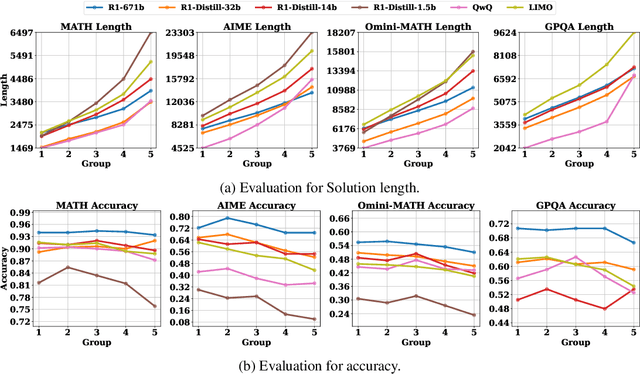
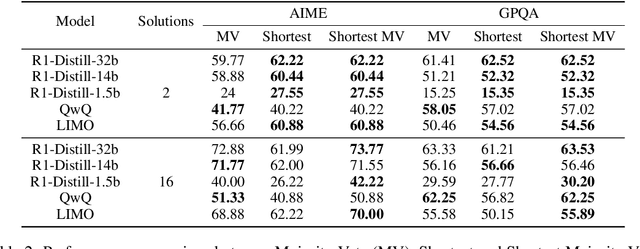
Abstract:The advent of test-time scaling in large language models (LLMs), exemplified by OpenAI's o1 series, has advanced reasoning capabilities by scaling computational resource allocation during inference. While successors like QwQ, Deepseek-R1 (R1) and LIMO replicate these advancements, whether these models truly possess test-time scaling capabilities remains underexplored. This study found that longer CoTs of these o1-like models do not consistently enhance accuracy; in fact, correct solutions are often shorter than incorrect ones for the same questions. Further investigation shows this phenomenon is closely related to models' self-revision capabilities - longer CoTs contain more self-revisions, which often lead to performance degradation. We then compare sequential and parallel scaling strategies on QwQ, R1 and LIMO, finding that parallel scaling achieves better coverage and scalability. Based on these insights, we propose Shortest Majority Vote, a method that combines parallel scaling strategies with CoT length characteristics, significantly improving models' test-time scalability compared to conventional majority voting approaches.
Unlocking Scaling Law in Industrial Recommendation Systems with a Three-step Paradigm based Large User Model
Feb 12, 2025Abstract:Recent advancements in autoregressive Large Language Models (LLMs) have achieved significant milestones, largely attributed to their scalability, often referred to as the "scaling law". Inspired by these achievements, there has been a growing interest in adapting LLMs for Recommendation Systems (RecSys) by reformulating RecSys tasks into generative problems. However, these End-to-End Generative Recommendation (E2E-GR) methods tend to prioritize idealized goals, often at the expense of the practical advantages offered by traditional Deep Learning based Recommendation Models (DLRMs) in terms of in features, architecture, and practices. This disparity between idealized goals and practical needs introduces several challenges and limitations, locking the scaling law in industrial RecSys. In this paper, we introduce a large user model (LUM) that addresses these limitations through a three-step paradigm, designed to meet the stringent requirements of industrial settings while unlocking the potential for scalable recommendations. Our extensive experimental evaluations demonstrate that LUM outperforms both state-of-the-art DLRMs and E2E-GR approaches. Notably, LUM exhibits excellent scalability, with performance improvements observed as the model scales up to 7 billion parameters. Additionally, we have successfully deployed LUM in an industrial application, where it achieved significant gains in an A/B test, further validating its effectiveness and practicality.
Scaling of Search and Learning: A Roadmap to Reproduce o1 from Reinforcement Learning Perspective
Dec 18, 2024



Abstract:OpenAI o1 represents a significant milestone in Artificial Inteiligence, which achieves expert-level performances on many challanging tasks that require strong reasoning ability.OpenAI has claimed that the main techinique behinds o1 is the reinforcement learining. Recent works use alternative approaches like knowledge distillation to imitate o1's reasoning style, but their effectiveness is limited by the capability ceiling of the teacher model. Therefore, this paper analyzes the roadmap to achieving o1 from the perspective of reinforcement learning, focusing on four key components: policy initialization, reward design, search, and learning. Policy initialization enables models to develop human-like reasoning behaviors, equipping them with the ability to effectively explore solution spaces for complex problems. Reward design provides dense and effective signals via reward shaping or reward modeling, which is the guidance for both search and learning. Search plays a crucial role in generating high-quality solutions during both training and testing phases, which can produce better solutions with more computation. Learning utilizes the data generated by search for improving policy, which can achieve the better performance with more parameters and more searched data. Existing open-source projects that attempt to reproduce o1 can be seem as a part or a variant of our roadmap. Collectively, these components underscore how learning and search drive o1's advancement, making meaningful contributions to the development of LLM.
Exploring the Benefit of Activation Sparsity in Pre-training
Oct 04, 2024
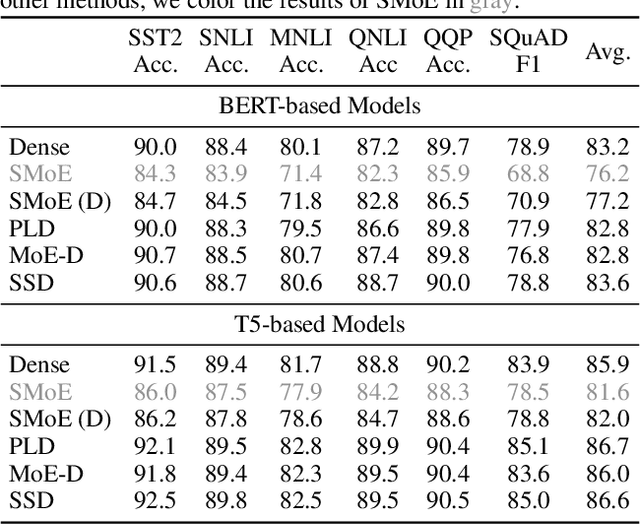
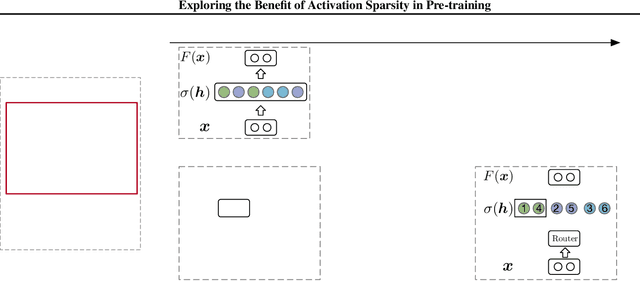
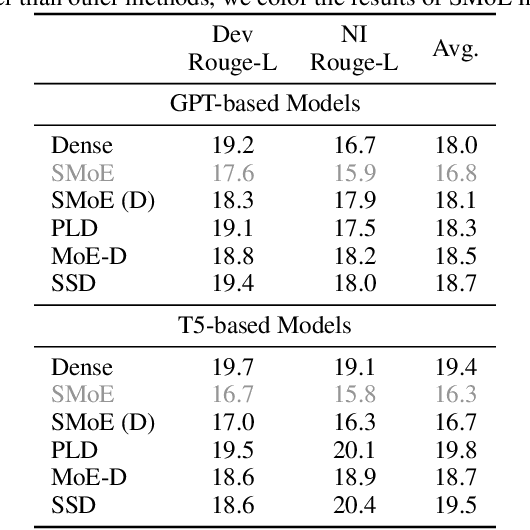
Abstract:Pre-trained Transformers inherently possess the characteristic of sparse activation, where only a small fraction of the neurons are activated for each token. While sparse activation has been explored through post-training methods, its potential in pre-training remains untapped. In this work, we first study how activation properties change during pre-training. Our examination reveals that Transformers exhibit sparse activation throughout the majority of the pre-training process while the activation correlation keeps evolving as training progresses. Leveraging this observation, we propose Switchable Sparse-Dense Learning (SSD). SSD adaptively switches between the Mixtures-of-Experts (MoE) based sparse training and the conventional dense training during the pre-training process, leveraging the efficiency of sparse training and avoiding the static activation correlation of sparse training. Compared to dense training, SSD achieves comparable performance with identical model size and reduces pre-training costs. Moreover, the models trained with SSD can be directly used as MoE models for sparse inference and achieve the same performance as dense models with up to $2\times$ faster inference speed. Codes are available at https://github.com/thunlp/moefication.
 Add to Chrome
Add to Chrome Add to Firefox
Add to Firefox Add to Edge
Add to Edge